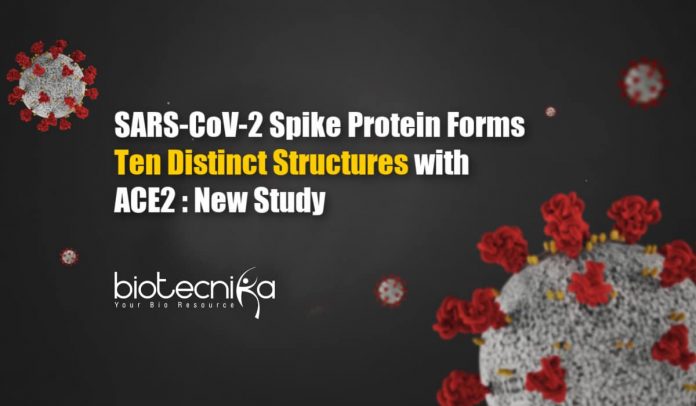Ten Distinct Structures Formed by SARS-CoV-2 Spike Protein
with ACE2 Protein: New Study Finds
The COVID-19 causing SARS-CoV-2 virus is able to infect human cells when the virus’s spike proteins bind to ACE2 cell surface receptors. In order to release the virus genome into the cell, the receptor binding is followed by the fusion of the cell membranes and the virus. Yet, it is still unknown how exactly the ACE2 binds to the SARS-CoV-2 spike. New biology regarding the binding has been uncovered in new research, which revealed that when the spike gets in contact with the human virus receptor ACE2, the spike can adopt at least ten distinct structural states.
Ten distinct structures that are associated with different stages of receptor binding and infection have been characterized by the researchers in the Crick’s Structural Biology of Disease Processes Laboratory in the first study to examine the binding mechanism between ACE2 and the spike protein in its entirety.
A postdoctoral fellow in the Structural Biology of Disease Processes Laboratory at the Crick, Donald Benton, Ph.D. said, “We have been able to characterize spike structures that are unique to SARS-CoV-2 by examining the binding event in its entirety. It was observed
that the stability of the protein will reduce as the spike becomes more open, which may increase the ability of the protein to carry out membrane fusion, allowing the virus to infect.”Before the team trapped different forms of the protein by rapid freezing in liquid ethane, a mixture of spike protein and ACE2 were incubated. They obtained tens of thousands of high-resolution images of the different binding stages as they examined these samples using cryo-electron microscopy.
The spike protein was observed to exist as a mixture of open and closed structures. The spike protein becomes more open following ACE2 binding at a single open site, which leads to a series of favorable conformational changes, priming it for additional binding. The virus is able to fuse to the cell membrane, permitting infection once the spike’s central core becomes exposed after it bounds to ACE2 at all three of its binding sites.
The spike glycoprotein is post-translationally cleaved, as well as the other class I membrane fusion proteins into S1 and S2 components (in this case by furin), which after the cleavage, stay related. Researchers noted that following receptor binding, the fusion activation is proposed to involve the exposure of a second proteolytic site (S2’), cleavage of which is need for the release of the fusion peptide. Using cryoEM, the binding of ACE2 to the furin-cleaved form of SARS-CoV-2 S was particularly investigated by the researchers. Additionally, the ten different molecular species classified by the authors included the fully open ACE2-bound trimer, the dissociated monomeric S1 bound to ACE2, and unbound, closed spike trimer. The journal Nature published this new work.
A postdoctoral fellow in the Structural Biology of Disease Processes Laboratory at the Crick, Antoni Wrobel, Ph.D. said, “We can understand which currently available anti-viral treatments are more likely to work or could expose new targets for treatments as we unravel the mechanism of the earliest stages of infection.”
Group leader of the Structural Biology of Disease Processes Laboratory at the Crick, Steve Gamblin, Ph.D. added saying, “There is still so much that we don’t know about SARS-CoV-2 virus. Yet, the pandemic can be managed by identifying the clues in the virus’s basic biology. Researchers could expose weaknesses to exploit by understanding what makes this virus distinctive.”
Source
Ten Distinct Structures Formed by SARS-CoV-2 Spike Protein with ACE2






























